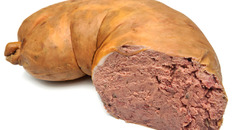Meats and Sausages
Jowl Sausage
Jowl Sausage (Kiszka Podgardlana) is all meat trimmings liver sausage with significant amount of jowls. A cross section of jowl looks like bacon; it is a bit tougher, but has a rich flavor. Jowls are rich in connective tissue which is the material that forms natural gelatin which in turn binds all ingredients together. You will find that jowls are incorporated in most head cheese and blood sausage recipes due to their binding properties.
| Meats | Metric | US |
|---|---|---|
| Pork, beef, veal or lamb liver | 100 g | 3.5 oz |
| Beef or lamb lungs or tripe, pork stomachs, veal casings, boiled beef, veal and lamb head meat (not salted), boiled bone meat, low grade pork trimmings, skwarki (* see note below) and skins, boiled pork or veal leg meat | 500 g | 1.10 lb |
| Jowls | 200 g | 7.0 oz |
| Semolina flour or bread crumbs | 200 g | 7.0 oz |
Ingredients per 1000g (1 kg) of meat
| salt | 20 g | 3-1/2 tsp |
| pepper | 1.0 g | 1/2 tsp |
| marjoram | 1.0 g | 1/2 tsp |
| allspice | 0.5 g | 1/4 tsp |
| onion, fresh | 30 g | 1/2 onion |
Instructions
- Poach meats (except liver and skwarki *) in small amount of water:
- lungs and veal casings at 80-85°C (176-185°F).
- other meats (except fat) at 95°C (203°F) until soft.
- fat at 85°C (185°F) until semi-soft. Save meat stock.
- After poaching remove gristle from lungs and meat from bones. Spread meats apart on a flat surface to cool.
- Grind fat, low grade pork and lungs through 3 mm plate. Grind all other meats through 3 mm plate and emulsify in food processor.
- Soak bread crumbs or dry rolls in 75% (in relation to the weight of the rolls) of left over meat stock.
- Emulsify semolina with 75% of left over stock. Emulsify separately tripe, stomachs and veal casings adding 10-15% of left over poaching stock. When emulsifying tripe, add salt and spices.
- Mix either emulsified semolina or bread crumbs with emulsified meats.
- Stuff loosely into pork middles and tie the ends with butcher's twine.
- Immerse sausages in boiling water and poach at 80-85°C (176-185°F) for 50-90 min until internal meat temperature reaches 68-70°C (154-158°F).
- Spread sausages on flat surface and cool them.
- Keep in refrigerator.
Notes
All meats not salted
Jowls can be substituted with small fat trimmings.
* Skwarki (pork cracklings) is the byproduct of making lard by fat rendering. Fatback is the preferred choice and skwarki with lard have always been used as butter substitute in Europe.
Skins and skwarki * see no more than 100 g (3.5 oz) each.
Dry bread rolls can be used instead of bread crumbs. Dry bread rolls can be substituted for bread crumbs. It was a common practice to save left over wheat roll to dry. Then they were soaked in meat stock, milk or water and mixed with meats.


















